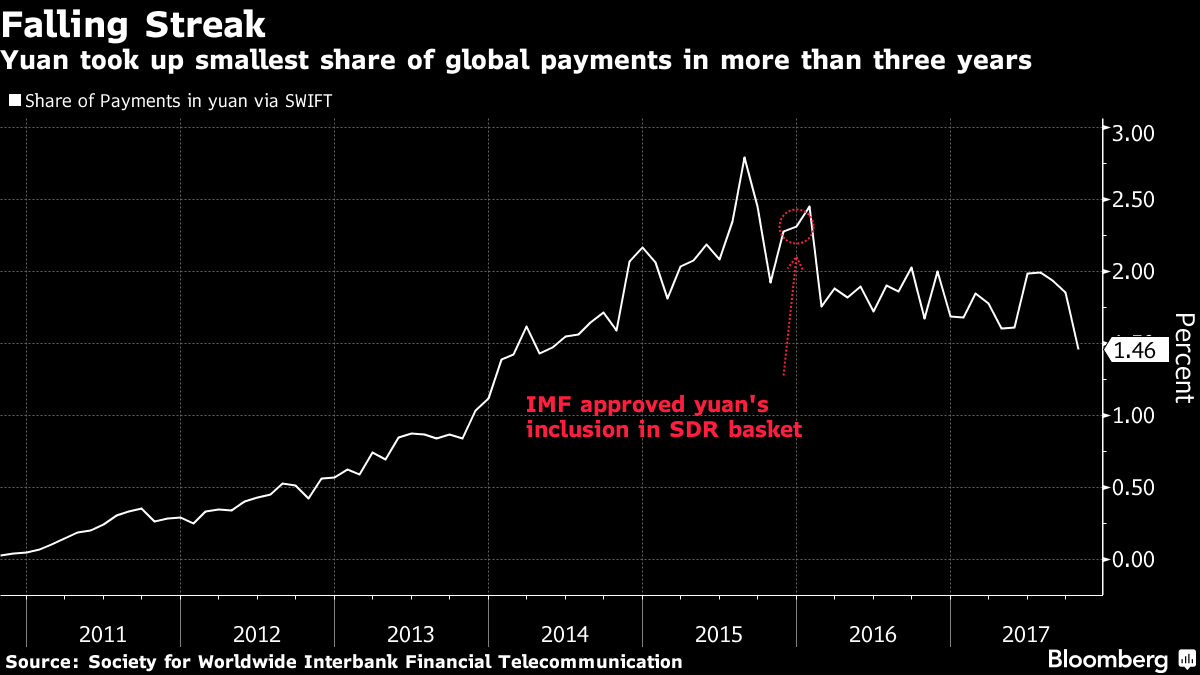China's moves to set up trading oil in yuan have sparkedenthusiasm about what could be a shift in the global financialsystem: a reduced role for the U.S. dollar. Players like AdamLevinson, founder of hedge fund Graticule Asset Management Asia,call it a “huge story” to come.
|But with policy makers prioritizing market stability overinternationalization, plans laid back in 2012 to begin oil-futurestrading priced in yuan or dollars in Shanghai that year are stillpending. The latest from the city's International Energy Exchange:It's coming soon, with test trades scheduled this weekend.
|“This contract has the potential to greatly help China's pushfor yuan internationalization,” said Yao Wei, chief China economistat Societe Generale SA in Paris. “But its success will hingecritically on the degree of freedom allowed for the capital flowsrelated to the contract.”
|As the world's largest energy consumer and an increasing sourceof investment capital for oil-producing nations, China has aninterest in using its own currency rather than that of ageopolitical competitor. One hurdle for setting up a rival toBrent or West Texas Intermediate: Overseas oil producers andtraders would need to swallow China's capital controls and penchantfor occasional market interventions.
|Similar hurdles have kept foreign investors as bit players inChina's giant mainland stock and bond markets.
|Chinese authorities have avoided the kind of big internationalpush that accompanied their campaign to get the yuan into theInternational Monetary Fund's basket of official reserve currenciesin 2015, suggesting ambitions for pricing commodities in yuanremain restrained for now. There was no mention of the petro-yuanin key National Development and Reform Commission documentsfollowing a pivotal October Communist Party leadershipgathering.
|The latest developments have been incremental. Shanghai's INEplans to conduct a drill to test trading, settlement and quotetransmission of crude futures Dec. 9-10. No date was announced forthe debut. Back when futures were proposed in 2012, it followedspikes in crude prices above $100 a barrel. Nowadays, oil is muchless costly, at under $60 and averaging little more than $50 thisyear.
|Saudi Hopes
The prospect of the Middle East embracing the petro-yuan hasbeen stoked in part by speculation that Saudi Arabia could announceit will accept the yuan for some of its exports to China.
|“The currency's influence in the region is set to grow in tandemwith Xi's proactive and assertive foreign policy,” economists ledby Chris Leung at the Singaporean bank DBS Group Holdings wrote ina report titled “China in 2018/19: The Age of the Strongman.” Xi'ssignature Belt and Road Initiative of developing ties acrossEurasia “will be an indispensable catalyst for greater use of theyuan on oil settlement,” the team wrote.
|Saudi Arabia's Energy Ministry and Saudi Aramco, its state-runoil company, declined to respond to requests for comment on beingopen to accepting yuan for payment. U.A.E. Energy Minister SuhailAl Mazrouei told reporters in Abu Dhabi Nov. 20 he didn't haveenough background on the potential petro-yuan to comment on it.
|One major challenge facing Middle East producers consideringaccepting a big share of their oil contracts in yuan would be theexchange-rate risk they would run, given that most of the regionmaintains currency pegs to the dollar.
|Dollar 'Entrenched'
“The dollar is so entrenched that it's difficult to see thatrole diminishing,” said Shady Shaher, head of macro strategy atDubai-based lender Emirates NBD PJSC. “It makes sense in thelong-run to look at transactions in yuan, because China is a keymarket,” though it will take years to develop, he said.
|Big Chinese participation in Aramco's planned initial publicoffering could help sway Saudi opinion toward accepting yuan, whichis used in less than 1.5% of global payments measured by Swift. Yetthe experience of Russia shows that even when leadership goals arealigned, yuan use can be slow to take off.
|China once had oil-futures trading, in the mid-1990s, beforeabandoning the effort along with trading in bond futures, due tovolatility. Concerns about destabilizing moves continue today,prompting intervention of one kind or another in markets fromstocks to the yuan, which has unusually low fluctuations in dailytrading relative to its counterparts.
|“Chinese regulators have made it clear that they want stabilityin financial markets, including the new futures contracts to belisted” for oil, said Li Zhoulei, an analyst with EverbrightFutures Co. in Shanghai. “”t remains to be seen how the crudecontract can gain influence and at the same time avoid excessivevolatility.”
|Missteps in moves to embrace a more flexible yuan in 2015prompted China to double down on controls since then, and there'sno clear sign they'll be lifted anytime soon.
|“It is not unreasonable to envision a world in which theoverwhelming share of commodity contracts, especially for oil, areno longer denominated just in dollars,” said Eswar Prasad, a formerChina division chief at the IMF. But “the yuan's role in globalfinance will ultimately be determined by the degree of commitmentof Xi Jinping's government to economic and financial marketreforms.”
From: Bloomberg News
|Copyright 2018 Bloomberg. All rightsreserved. This material may not be published, broadcast, rewritten,or redistributed.
Complete your profile to continue reading and get FREE access to Treasury & Risk, part of your ALM digital membership.
Your access to unlimited Treasury & Risk content isn’t changing.
Once you are an ALM digital member, you’ll receive:
- Critical Treasury & Risk information including in-depth analysis of treasury and finance best practices, case studies with corporate innovators, informative newsletters, educational webcasts and videos, and resources from industry leaders.
- Exclusive discounts on ALM and Treasury & Risk events.
- Access to other award-winning ALM websites including PropertyCasualty360.com and Law.com.
*May exclude premium content
Already have an account? Sign In
© 2024 ALM Global, LLC, All Rights Reserved. Request academic re-use from www.copyright.com. All other uses, submit a request to [email protected]. For more information visit Asset & Logo Licensing.






